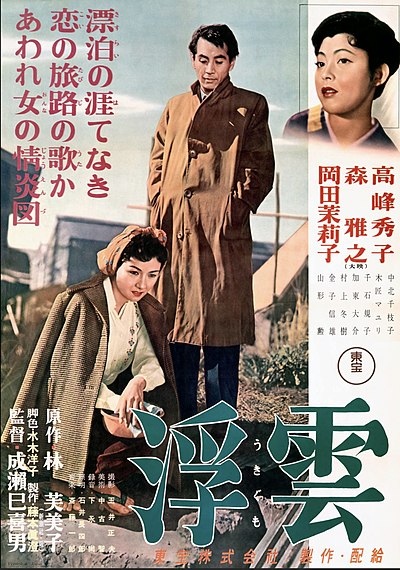
Search
Floating Clouds

Floating Clouds (Japanese: 浮雲, Hepburn: Ukigumo) is a 1955 Japanese drama film directed by Mikio Naruse. It is based on the novel Ukigumo by Japanese writer Fumiko Hayashi, published just before her death in 1951. The film received numerous national awards upon its release and remains one of director Naruse's most acclaimed works.
Plot
The film follows Yukiko, a woman who has just been expatriated from French Indochina, where she has been working as a secretary for a forestry project of the Japanese wartime government. In Tokyo, Yukiko seeks out Kengo, one of the engineers of the project, with whom she had an affair and who had promised to divorce his wife Kuniko for her. They renew their affair, but Kengo tells Yukiko he is unable to leave his sickly wife. She becomes the mistress of an American soldier as a means to survive in times of economic restraint. Still, Yukiko can't cut ties with Kengo, although he even starts an affair with a married younger woman, Osei. Pregnant from Kengo, Yukiko has an abortion. She later hears from Kengo that Kuniko has died from illness. Eventually, Yukiko follows Kengo to his new job on Yakushima island, where she dies of her bad health and the humid climate.
Cast
Reception
Film director Yasujirō Ozu saw Floating Clouds upon its release and called it "a real masterpiece" in his journals.
Awards
- 1956: Blue Ribbon Awards for Best Film
- 1956: Kinema Junpo Award for Best Film, Best Actor (Masayuki Mori), for Best Actress (Hideko Takamine), and for Best Director (Mikio Naruse)
- 1956: Mainichi Film Concours for Best Film, for Best Actress (Hideko Takamine), for Best Director (Mikio Naruse), and for Best Sound Recording (Hisashi Shimonaga)
Legacy
Floating Clouds is Naruse's most popular film in Japan. It ranked number three of the best Japanese film of all time in a poll of 140 Japanese critics and filmmakers conducted by the magazine Kinema Junpo in 1999. Filmmaker Akira Kurosawa cited the film as one of his 100 favourites.
It was screened at the Berkeley Art Museum and Pacific Film Archive in 1981, at the Museum of Modern Art in 1985, and at the Harvard Film Archive in 2005 as part of their retrospectives on Mikio Naruse, and at the Cinémathèque Française in 2012 and 2018.
Analysis
Adrian Martin, editor of on-line film journal Rouge, has remarked upon Naruse's cinema of walking. Bertrand Tavernier, speaking of Naruse's Sound of the Mountain, described how the director minutely describes each journey and that "such comings and goings represent uncertain yet reassuring transitions: they are a way of taking stock, of defining a feeling". So in Floating Clouds, the walks down streets "are journeys of the everyday, where time is measured out of footfalls, – and where even the most melodramatic blow or the most ecstatic moment of pleasure cannot truly take the characters out of the unromantic, unsentimental forward progression of their existences."
Film scholar Freda Freiberg has remarked on the terrain of the film: "The frustrations and moroseness of the lovers in Floating Clouds are directly linked to and embedded in the depressed and demoralised social and economic conditions of early post-war Japan; the bombed-out cities, the shortage of food and housing, the ignominy of national defeat and foreign occupation, the economic temptation of prostitution with American military personnel."
Notes
References
External links
- Floating Clouds at IMDb
- Floating Clouds at Rotten Tomatoes
Text submitted to CC-BY-SA license. Source: Floating Clouds by Wikipedia (Historical)
Owlapps.net - since 2012 - Les chouettes applications du hibou


